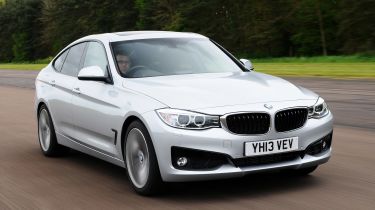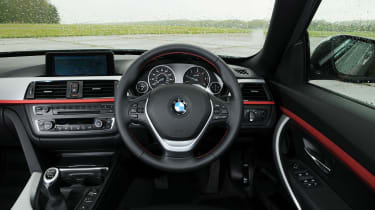Used BMW 3 Series GT (2013-2019) review: a five-door hatch that's easy to like
A full used buyer’s guide on the BMW 3 Series Gran Turismo that was on sale between 2013 and 2019
Verdict
This is a car that’s very easy to like. There are no electrified powertrains, while the driver-assistance systems aren’t up to the latest standards. But for many this is a good thing because there’s less to go wrong. Most importantly there’s everything you need and not very much (if anything) that you don’t. As with all BMWs, if you decide the 3 Series GT is for you, check out the exact spec very carefully, because lots of these cars had plenty of extras fitted, while others had hardly any at all. Also be sure to get the right engine for your needs; what’s under the bonnet will affect the driving experience and the running costs. But if you buy the right example you’ll love driving and owning the 3 Series GT.
Soon the BMW 3 Series will celebrate its 50th birthday, and over the course of its seven generations, the range has expanded substantially.
A decade ago, as part of the Mk6 edition, BMW launched a five-door hatchback version for the first time, called the 3 Series Gran Turismo, or GT. It was a far cry from that first model in 1975, which only came in two-door saloon form.
The 3 Series has always been impressive in terms of its ergonomics, build quality and driving experience, and by the time the Mk6 arrived, BMW had honed its all-conquering compact executive to near-perfection. That’s why, a decade after its introduction, the 3 Series GT is still worthy of consideration.
History
The 3 Series GT went on sale in the UK in June 2013, in 181bhp 320i, 241bhp 328i and 301bhp 335i petrol-engined forms. Diesel fans could choose between 141bhp 318d and 181bhp 320d engines or a 215bhp 325d, with all powertrains featuring four cylinders, apart from the six-pot 335i.
Used - available now

2022 Kia
e-Niro
33,290 milesAutomaticElectric
Cash £20,197
2021 BMW
1 Series
60,610 milesAutomaticPetrol1.5L
Cash £17,697
2014 BMW
1 Series
130,000 milesManualDiesel2.0L
Cash £4,498
2014 Ford
C-Max
39,000 milesManualPetrol1.0L
Cash £4,898In February 2014, two new diesel engines joined the range: the 254bhp 330d and the 309bhp 335d. The latter came with BMW’s xDrive four-wheel-drive transmission; this was optional on the 330d, which came as standard with rear-wheel drive.
A facelifted 3 Series GT arrived in June 2016, with the 248bhp 330i replacing the 328i, while a 321bhp 340i replaced the 335i; all other engines were carried over. The interior was upgraded, the engines were more efficient than before and the exterior styling was refreshed.
Which one should I buy?
You can’t really go wrong whichever 3 Series GT you buy, because they’re all good to drive – even the entry-level 318d is fine. However, buy at least a 320i or 320d and you’ll have decent performance, while the six-cylinder models are seriously quick.
The entry-level SE has dual-zone climate control, a powered tailgate, cruise control, a DAB radio, rear parking sensors, 18-inch alloy wheels and automatic headlights. The Sport has only cosmetic changes apart from the addition of sports seats and a three-spoke steering wheel.
Luxury adds leather trim while the M Sport has typically racy styling inside and out, sport suspension and seats. There’s little difference in equipment between the various trims; they differ mainly in terms of design and finish for items such as wheels, trim and instrumentation.
Alternatives to the BMW 3 Series GT
The closest alternative is a BMW 4 Series Gran Coupé, which is almost identical to the 3 Series GT. It’s less comfortable and more cramped inside, but even better dynamically. Or you could go for a 3 Series saloon or Touring (estate), because they share much of their interior and mechanicals with the GT.
If you don’t want a BMW, Audi can oblige with the A5 Sportback, which is extremely refined and offers a good choice of engines. The downsides are that it isn’t as good to drive as a 3 Series GT and doesn’t offer as much cabin or boot space.
Other than that you’re looking at the usual compact executive saloon and estate suspects: the Audi A4, Jaguar XE, Lexus IS and Mercedes C-Class.
What to look for
Tyres
All 3 Series GTs had run-flat rubber but you can switch to regular tyres and carry a space-saver spare. Make sure it’s present.
Timing chain
On early cars the timing chain tensioner could fail, leading to big engine damage. Any such cars should have been fixed by now.
Clocking
It’s easy to clock a 3 Series, but the correct diagnostic tool will soon uncover if the car’s odometer has been wound back.
Misfires
Failed ignition coils can lead to petrol-engined cars misfiring. New coils are a consumable and readily available at around £50 each.
Interior
Although the GT is based on the 3 Series, it has extra rear-seat space because the wheelbase was stretched by 110mm; there’s more legroom than in the contemporary 5 Series. This also leads to improved ride comfort, while the back seats sit higher so feel less confined.
The dashboard is taken straight from the other 3 Series models, so it’s well made and easy to get on with, which pretty much sums up the cabin as a whole. The boot is also impressive with its 520-litre capacity, which jumps to a healthy 1,600 litres if the back seats are folded down.
Prices
Three-quarters of the GTs for sale are M Sports, making it easily the most popular trim. The vast majority of GTs are diesels and most have an automatic transmission, while one in three is four-wheel drive.
To check prices on a specific model head over to our valuation tool.
Running costs
All GTs have condition-based (variable) servicing, so the car flags up when attention is needed, and no two service costs are the same. However, services are usually needed every 16,000 miles or two years, and for an oil and filter change you can expect to pay around £215. Add an air filter and spark plugs and the bill will go up to £475. The brake fluid should be renewed every two years (£68) and because all engines are chain-driven, no timing belts are ever required.
Recalls
The 3 Series GT has been affected by 10 recalls, virtually all of which have also included most of BMW’s range. As a result some recalls have affected large numbers of cars (as many as 322,745 in one case).
The same problem has been behind multiple recalls in some instances; exhaust gas recirculation cooler leaks were the reason for four recalls (November and December 2018, then two in August 2022), while crankshaft sensor software glitches led to two campaigns, in August and October 2018.
Faulty fuel pumps led to a recall in June 2015, with power steering failures leading to one in December 2016. Airbags not deploying were the reason for recall three, in January 2017; airbags inflating too aggressively led to the most recent campaign, in January 2023.
Driver Power owner satisfaction
The GT is too niche to have appeared in our Driver Power surveys, but the 3 Series Mk6 has been included. The last time it featured in a new-car survey was in 2018, when it came 39th out of 75. In this year’s used-car poll it was 72nd out of 75 cars. It scored badly in all areas bar infotainment; 71st for ride/handling was a shock, while 67th for running costs and 68th for practicality are disappointing.
Looking to sell your current car quickly and for a good price? Try our Free Car Valuation tool today!









